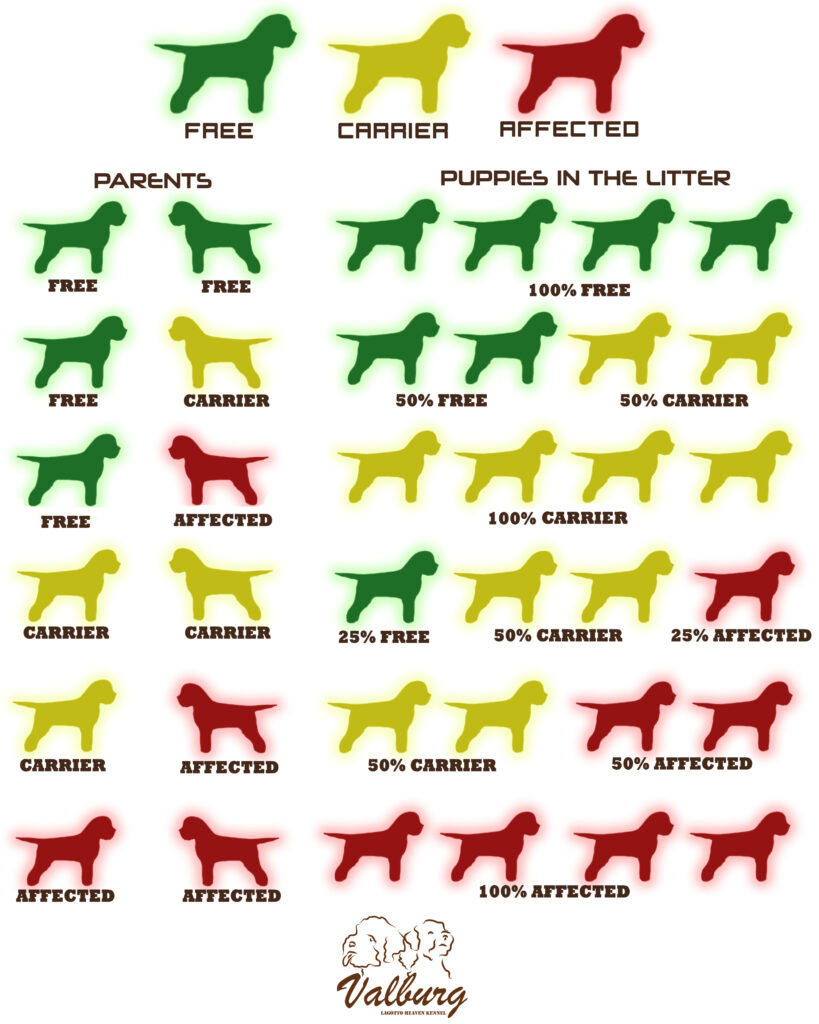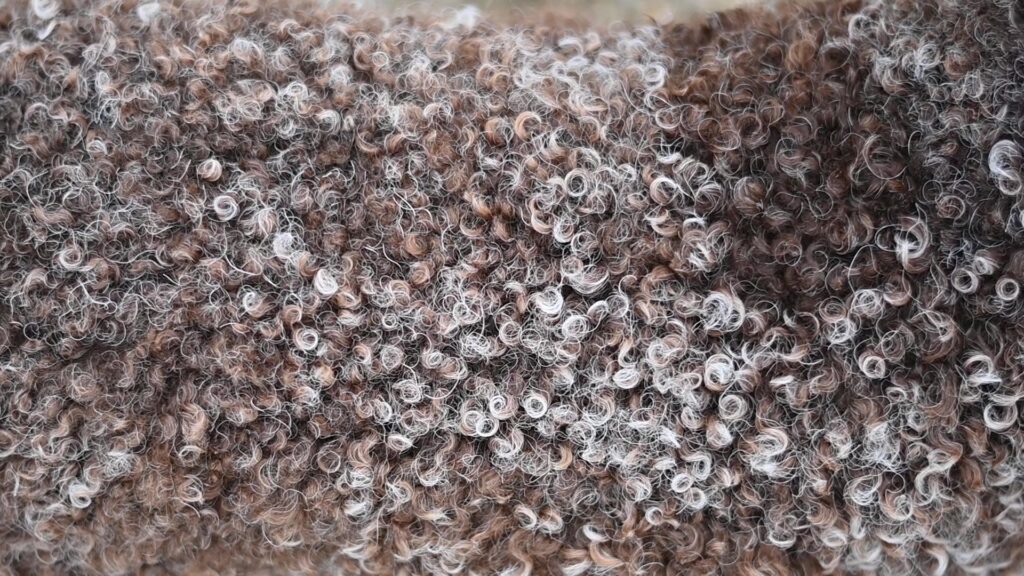In the maze of health screenings
What do all those acronyms mean?
Before buying a puppy, responsible prospective owners do a thorough research into the breed to get the needed knowledge for choosing the right breeder and puppy.
For the uninitiated, it's not so simple to navigate in the world of health tests because many acronyms are used when displaying them. Many wonder what the results of these tests actually mean.
Genetic screenings
The genetic tests are done by collecting blood or saliva sample. The examination of these samples is executed by accredited labours. We can either order just one test at a time, or even an entire palette of the presently available genetic screenings, which gives the opportunity to test for more than 200 diseases at the same time. It's important to know though that there are breed specific diseases; in Lagottos, the six following tests are the most relevant:
LSD – Lagotto Storage Disease: A severe neurodegenerative disease which eventually leads to death. Dogs affected by this condition show a variety of neurological signs, which may include changes in behaviour, coordination problems and facial and eye tics.
JE – Benign Familial Juvenile Epilepsy: Juvenile epilepsy is a neurological disease. Affected dogs suffer from epileptic seizures (body tremors, uncoordinated movement and stiffness) from 5-9 weeks of age until 4 months of age, after which the seizures cease.
NAD – Neuroaxonal Dystrophy: affected dogs show a variety of neurological abnormalities, including gait abnormalities and behavioural disturbances.
Symptoms include slowly progressive neurological signs that begin between six and eleven months of age. Owners of affected dogs have reported gait abnormalities, behavioural changes (dullness, nervousness, vocalisation) and incontinence.
prcd-PRA – Progressive rod-cone degeneration: progressive retinal atrophy (PRA) is a hereditary disease that occurs in many breeds and in different forms. It is a disease that progressively worsens, eventually leading to complete loss of vision in the dog.
HUU – Hyperuricosuria / Urate Stones: Hyperuricosuria is characterised by the elevated levels of uric acid in the urine. This disease predisposes dogs to the formation of stones in their bladder or sometimes in their kidneys.
Furnishings – Furnishing refers to the longer whiskers and eyebrows seen in wirehaired dogs and other breeds. It is a dominant variant of the R-spondin-2 gene that produces the desired coat texture and growth pattern.
What are the possible results of genetic tests and what do they actually mean?
There are three possible outcomes:
- Clear: this does not need much explanation, the dog is healthy and breedable.
- Carrier: the dog carries the gene in its genes but will not be sick, is perfectly healthy and breedable!
- Affected: the individual is sick, not breedable.
In a nutshell, the clear and carrier individuals are breedable. Nevertheless, one thing to note is that carrier individuals can only be bred to one with clear result. In this case, the pups will be clears or carriers, so completely healthy.
The figure below illustrates this:

Musculoskeletal disorders, dysplasia
The musculoskeletal diseases are tested by physical examination, using x-rays. It is crucial to highlight that these are not genetic filtrasions, it only applies to the given individual's healthiness. This examination does not guarantee that the puppies of the individual will be completely healthy.
The predisposition for dysplasia is inheritable (even though the current state of science has not found a way to test it genetically), and, unfortunately, this disease can also be acquired; the insufficient keeping conditions can significantly increase its occurance. However, if the puppy is from filtered parents and the breeder's advices regarding animal husbandry and feeding are taken, chances are great to have a healthy puppy.
What influences its development?
It's extremely important from the first moments at the breeder for the puppy to not be kept on a slippery surface, and the prospective owner should continue to keep the puppy on such surface.
The proper nutrition, including the quality nutrients is essential, just like keeping the puppy in ideal condition; the worst thing you can do is fattening it up. Overweightness highly contributes to developing dysplasia.
Attention has to be paid to the puppy's movement, a growing organism must not be exposed to extreme load.. You had better take it for a walk more often, for shorter periods, ecpecially in the beginning. Bigger tours and runs are only recommended after the dog turns 1 year.
Common types of musculoskeletas disorders:
HD - Hip Dysplasia: hip dysplasia consists of several grades:
- free (HD-, A, -, HD/A) – breedable
- fair, (HD-/+, B, HD/B) – breedable
- Mild, (HD+, C, HD/C) – breedable
- moderate (HD++, D, HD/D) – NOT breedable
- severe (HD+++, E, HD/E) – NOT breedable
Free, fair and mild results are healthy and breedable. Care should be taken to mate a mild result with a free individual if possible (some clubs even prescribe this).
Individuals with moderate to severe results MUST NOT BE BRED, however, it is important to note that in most cases they can live a full life if the right living conditions are provided.
ED – Elbow dysplasia: elbow dysplasia also consists of several grades:
- normal (free) /grade 0/; – breedable
- mild /grade I/; – breedable
- moderate /grade II/; – not breedable
- severe /grade III/ – not breedable
OCD – oszteochondrózis dissecans: a shoulder dysplasia. The first symptoms of the disease begin at 7-9 months of age, with recurrent forelimb lameness. Painful stretching of the shoulder joints. The screening test for shoulder dysplasia is yet to be fully standardised, so only the free or shoulder dysplasia (subluxated) categories and the OCD positive and OCD negative categories are known.
Patella: knee cap dislocation, also classified in several categories:
- Free (Grade 0): patella is not dislocatable at the extended knee, no deviation is felt – breedable
- Grade I: The patella is easily dislocated at the extended knee, but is repositioned when released – breedable
- Grade II: Patella often dislocates on its own and sometimes it remains – not breedable
- Grade III: Patella permanently dislocated, with tibial torsion and tibial tarsus deviation of between 30 and 50 degrees off-axis – not breedable
- Grade IV: Patella permanently dislocated, tibia torsion and tibia tarsus deviation between 50 and 90 degrees – not breedable
The range of mandatory health screenings varies from country to country, so before buying a puppy, find out what screenings the parents have. In Hungary, for example, in the case of the lagotto romagnolo, HD, and ED results are musts to have.






